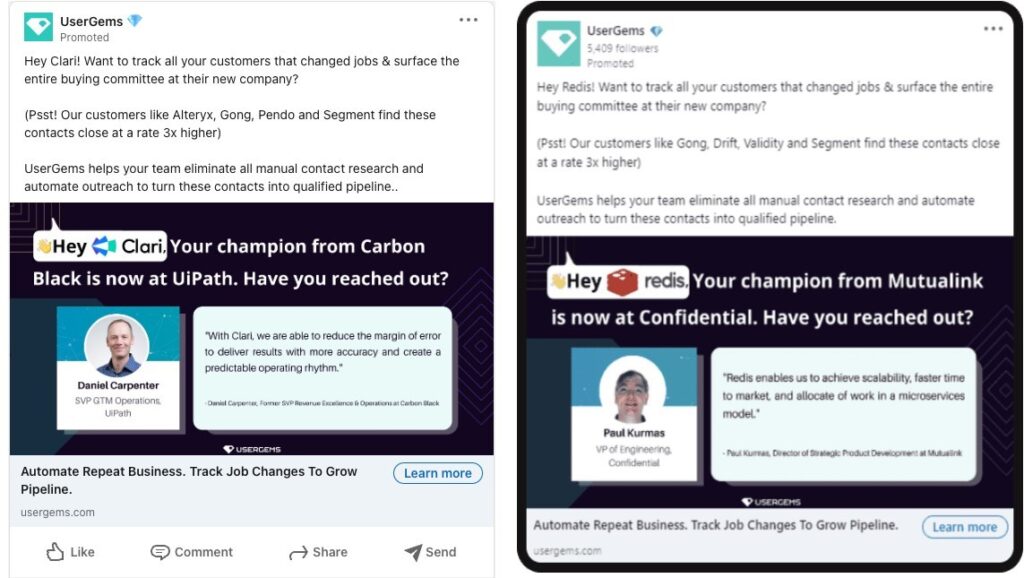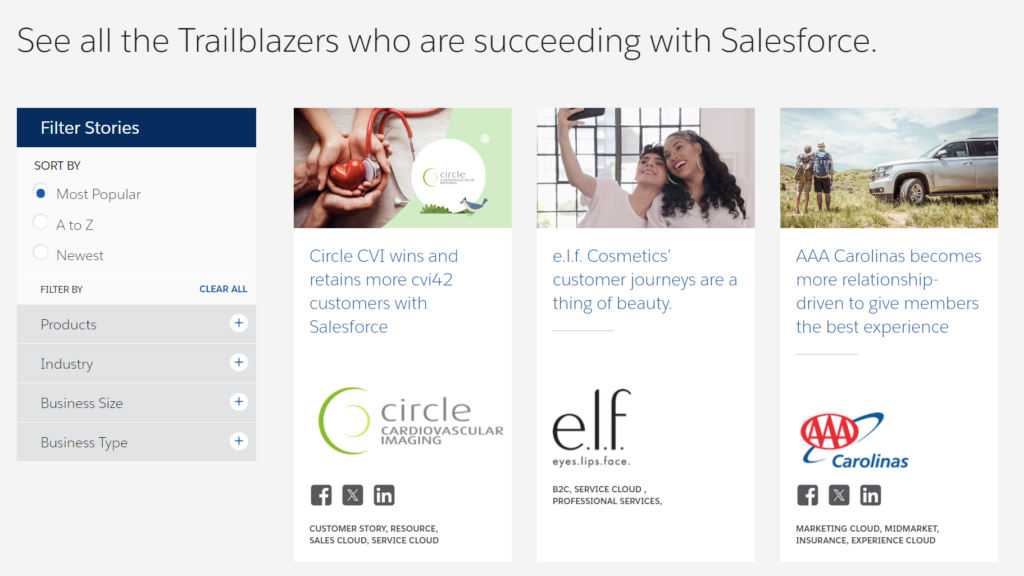Everyone seems to agree that ABM content strategy is key to success with an ABM program. Most especially because of its ability to improve your personalization strategies in account-based marketing (ABM).
But how do you take advantage? What formats work best?
In this article, I explore how to approach content depending on your ABM strategy, and the content formats that stand out and earn you attention from your target accounts.
But first, let's talk about the role of content in winning ABM playbooks.
The Role of Content in ABM
First, what exactly is ABM content?
Content plays an important role in brand awareness, managing your key accounts, department alignment, and lead nurturing, making it a crucial part of an account-based approach. Here's how...
Content Builds Thought Leadership and Establishes Your Company as an Industry Expert
Data from LinkedIn shows that 75% of B2B buyers use social media for research and buying decisions. Content, such as thought leadership, allows you to connect with prospects on social platforms and position your brand as a trusted authority.
By producing high-quality content that addresses industry challenges, trends, and innovations, your brand becomes an invaluable resource for your target audience. This enhances both brand awareness and brand equity in the long term.
Content Accelerates Sales and Marketing Alignment
Marketing and sales teams often operate in silos, resulting in disjointed communication and misaligned messaging. However, content serves as a common thread, improving how marketing and sales work together. It also aligns sales enablement and ABM into a single GTM approach.
Understanding the sales process will equip your marketing teams with the knowledge to refine content marketing and targeting. Armed with tailored content, sales reps can engage prospects in meaningful conversations, leading to accelerated sales cycles and increased revenue.
Content Nurtures and Engages Prospects Throughout the Buyer Journey
Careful content planning ensures leads are nurtured and engaged at every stage of the buyer's journey. From awareness through to decision, each piece of content serves a specific purpose, guiding target accounts through the buying process toward conversion.
Content Supports ABM Personalization
Content is key for ABM personalization because it bridges the gap between communication and scalability in your ABM approach. Through relevant content, you can address key accounts' unique pain points and needs in a flexible and efficient format.
Without it, you're limited to direct communication and advertising, which may not align with your prospect’s needs and position in the sales funnel. But content? It meets stakeholders where they are – whether it's a helpful blog post, an engaging video, or an interactive webinar.
The Three Types of ABM Content Strategies
There are three ways to approach content within your ABM strategy. The best approach for your company will depend on factors such as the number of targeted accounts, their financial value, and their alignment with your ideal customer profile (ICP). Here are the three types of account-based marketing:
One to Many ABM Content Strategy for Campaigns Targeting Scale
One-to-many ABM, also called Programmatic ABM, aims to reach a large number of target accounts simultaneously. In this approach, your content marketing strategy focuses on common challenges experienced by your target market.
Marketing automation tools and CRM gather this data and segment groups based on industry, expertise, and company size.
Other factors, such as buyer personas, demographics, target audience pain points, browsing behaviour, and technographic data are used to tailor content and marketing campaigns further.
This approach is best for smaller B2B companies with limited budgets, resources, and time. Prioritizing a broader audience of target accounts ensures your marketing efforts remain cost-effective yet impactful.
Best Practices
- Leverage marketing tools and CRM for a data-driven approach to content creation.
- Use content formats like infographics and webinars to attract the attention of your target market.
- Maintain consistency in messaging across all touchpoints.
- Monitor and analyze engagement metrics to refine content strategy.
- Experiment with different content distribution channels to maximize reach.
One to Few ABM Content Strategy for Campaigns Targeting Account Groups
In this strategy, the focus shifts to a select group of target accounts that share similar characteristics or belong to specific industries or verticals. Target account lists and lead scoring play an important role here in prioritizing and distinguishing accounts that face similar challenges, goals, and needs.
This style of ABM program is best suited for B2B companies with flexible budgets and the ability to introduce new team members and specialized ABM software as needed.
Best Practices
- Develop in-depth target account lists and ICPs to group similar customer personas.
- Prioritize account research to tailor messaging and content delivery.
- Collaborate with sales teams to align content with account-specific goals and objectives.
- Utilize dynamic content delivery platforms to adapt the content in real-time based on account interactions.
One-to-One ABM Content Strategy for Campaigns Targeting Specific Accounts
One-to-one marketing, also known as Strategic ABM, targets select high-value accounts with hyper-personalized content. This strategy builds authentic connections and showcases relatability through personalized content experiences.
ABM personalization at this level requires effective collaboration between marketing, sales, and executive leadership. This resource- and time-intensive form of B2B marketing is best suited for businesses with a large budget and dedicated teams.
Best Practices
- Incorporate personalized video messages or personalized landing pages to enhance engagement.
- Continuously iterate and optimize content strategy based on account feedback and engagement metrics.
Most-Used Account-Based Marketing Content Formats
Once you’ve selected your account-based marketing strategy and approach to content, your next step is to pinpoint the types of content that work best for your ABM efforts.
To inspire your choice, let’s review the most popular forms of content used for ABM initiatives. This includes podcasts, webinars, email campaigns, and more.
Podcasts and Interview Series
Like radio shows of days past, podcasts are known for their industry discussion, often featuring expert guests. For example, The Growth Show by Hubspot showcases thought leaders and explores topics, trends, and tactics within digital marketing.
To create entertaining and informative podcasts to support your ABM tactics, it’s best to:
- Keep episodes concise and on-topic throughout.
- Provide actionable insights and takeaways.
- Promote across relevant channels
Webinars
Webinars are live or recorded online seminars that offer educational content and interactive Q&A sessions. For example, Search Engine Journal is known for its webinars on search engine optimization (SEO), which provide tips and strategies for keyword research, link building, and more.
To maximize the impact of your webinars in your ABM strategy, consider the following best practices:
- Promote the webinar early and often.
- Engage the audience with polls and interactive Q&A sessions.
- Provide valuable follow-up resources to attendees.
- Invest in webinar software to scale your audience reach.
Personalized Landing Pages
Personalized landing pages are tailored web pages designed to resonate with specific target accounts, offering customized content and messaging. Unlike generic landing pages, personalized landing pages address individual accounts or stakeholders' unique needs, pain points, and interests.
A great example of this is Mutiny, a company known for its AI-powered personalized micro-sites. Mutiny knows a thing or two about personalizing landing pages and has employed this approach for its own ABM marketing.
To create and personalize your landing pages within a targeted ABM approach, follow these best practices:
- Use dynamic content to tailor the page to the account's needs.
- Align the messaging with the account's pain points and challenges.
- Track engagement metrics to measure effectiveness.

Creating personalized landing pages that resonate with specific target accounts can lead to higher engagement. Review these ABM statistics to learn more about the impact of personalization.
Personalized Social Ads
Personalized social ads leverage personalization and dynamic content to resonate with individual accounts, increasing engagement and conversion rates.
For example, UserGems employs a personalized approach to LinkedIn ads, targeting sales reps with ads that dynamically include their company name and pull specific social proof relevant to the account.
For effective personalized social ads in your ABM campaigns, consider these best practices:
- Utilize dynamic content to personalize ad messaging, including the company name and relevant social proof.
- Segment your audience effectively to ensure ads are delivered to the most relevant accounts.
- Craft compelling ad copy that speaks directly to the pain points and challenges of the target accounts.
- A/B test different ad formats and creatives to optimize performance and engagement.
- Monitor ad performance closely and adjust targeting and messaging based on real-time insights.
- Provide clear calls-to-action (CTAs) that encourage desired actions, such as downloading a resource or scheduling a demo.

Sales Enablement Content
Sales enablement content refers to materials such as case studies, one-pagers, and comparison guides. For example, Salesforce's case studies showcasing customer success stories are a prime example of effective sales enablement content.
To ensure the effectiveness of your sales enablement content, follow these best practices:
- Highlight tangible results and outcomes achieved by your product or service.
- Align content with different stages of the buyer journey to provide relevant information at each stage.
- Make content easily accessible to sales teams through centralized repositories or CRM platforms.

Email Outreach
Email outreach involves personalized email campaigns sent directly to key contacts within target accounts, offering valuable insights and resources. Thanks to generative AI and automation, personalized email outreach is now simpler to create and more effective. In fact, 95% of marketers say generative AI is effective for improving their email marketing.
However, Isaac Ware cautions against leaning too heavily on AI content.
With that in mind, when creating personalized email outreach, it’s best to:
- Segment email lists based on account characteristics and buyer personas.
- Craft compelling subject lines that grab attention and encourage opens.
- Provide clear calls-to-action (CTAs) in all emails to prompt desired actions from recipients.
- Maintain a “human” element to your communication, such as a personal follow-up email.
Video Content
Video content offers an engaging way to educate, entertain, or demonstrate value to target accounts. Short-form video yields the highest ROI, and it’s best to use educational insights and step-by-step guides.
Other ABM video best practices to keep in mind include:
- Keep videos concise and focused on key messages.
- Use storytelling techniques to make content more relatable and memorable.
- Optimize videos for different platforms and devices to reach a wider audience.
To learn more about how to utilize short-form video in a B2B context, check out our complete guide on B2B short-form video.
Best Practices for Getting Your ABM Content Program off the Ground
Embarking on an ABM content strategy requires careful planning and execution. Here are some best practices to help you kickstart your ABM content program:
Identify and Research Your Target Accounts
Before diving into content creation, take the time to identify and research your target accounts. Understand their industry, pain points, challenges, and goals.
Start by building out an in-depth target account list and identifying your ICP. From there, utilize CRM and marketing automation tools to dive deeper into the mind of your ideal customer. This arms your teams with the information needed to create impactful content for your ABM strategy.
Identify and Research Your Key Decision Makers
In addition to understanding your target accounts, it's essential to identify and research the key decision-makers within those accounts. Determine who holds the buying power and influence, and tailor your content to address their specific concerns and priorities.
Use contact mapping to identify and understand the relationships within key accounts. Look into data points such as job titles, departmental responsibilities, and organizational charts to filter and segment contacts within each company.
Align Your Content Angles with Your Audience Interests and Pain-points
Hooking readers and tailoring your content to meet them at their stage in the buyer's journey is essential. This means understanding their intent and providing content that addresses their specific needs and concerns. One valuable tool for achieving this is customer intent data.
Intent data provides insights into your target audience's actions, behaviors, and interests, helping you understand their intent at various stages of the buyer's journey. By leveraging this data, you can create content that aligns with their interests and pain points, increasing its relevance and effectiveness.
Measure and Optimize Your Content Process Continuously
No content marketing strategy is complete without continuous monitoring and iteration. Track metrics such as engagement, lead generation, account penetration, revenue, and customer lifetime value to gauge the impact of your content efforts.
Some form of ABM software or analytics monitoring software is crucial for this step. Google Analytics is a fantastic free option or look into Uberflip for managing content throughout your sales funnel. For more information on these tools, take a peek at our full review of the best account-based marketing software.
Build Better Relationships With Powerful, Targeted Content!
As we wrap up, it's clear that ABM content strategy is evolving, and success lies in adapting to these changes. You can drive meaningful engagement and business growth by focusing on creating valuable, relevant content that resonates with your target audience, leveraging data-driven insights, and continuously monitoring and optimizing your efforts.
Ready to take your ABM content strategy to the next level? Subscribe to The CMO newsletter for more insights, tips, and strategies to elevate your marketing efforts
P.S. - If you’re hungry for more ABM inspiration, keep reading with our round-up of account-based marketing examples from top companies around the globe!



